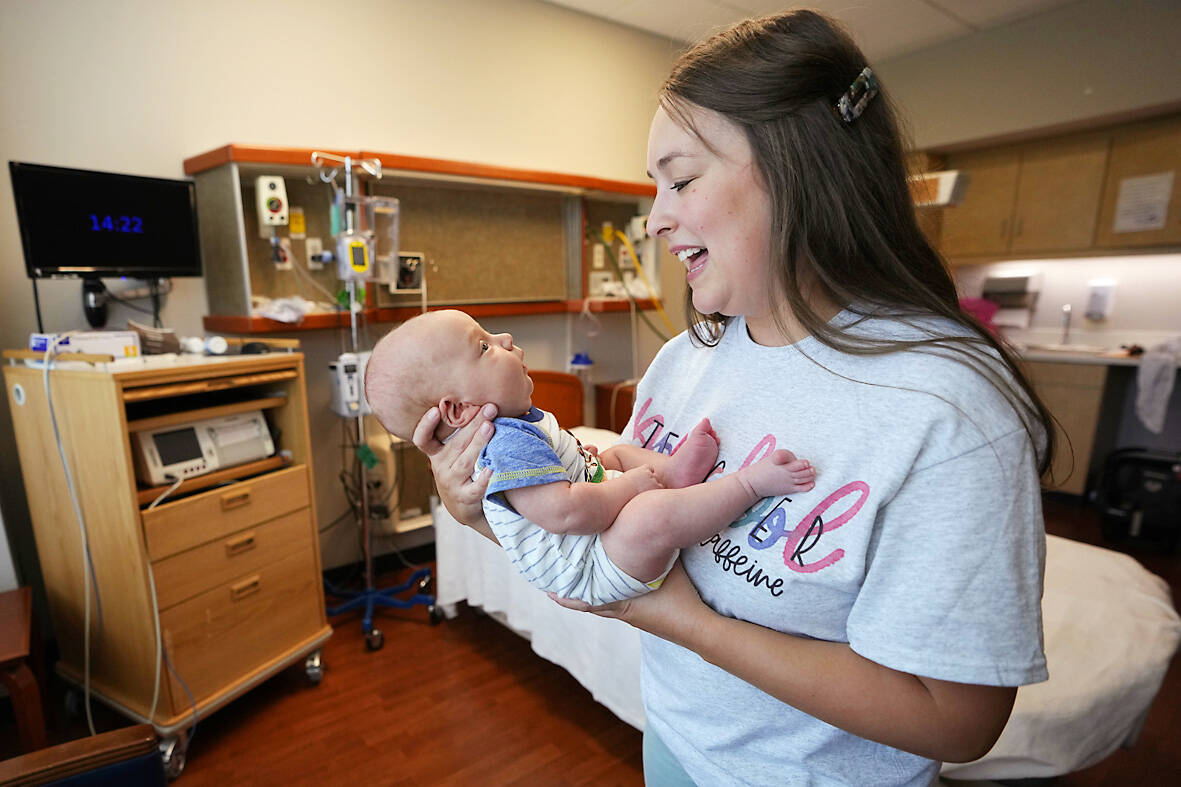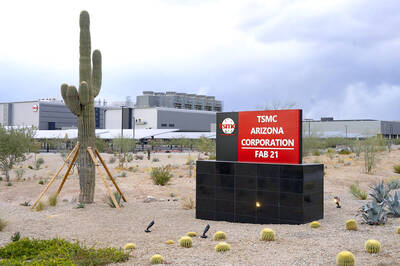How old is Dorothy? How about Susan, Tyler or Jayden?
These names were popular in the 1920s, 1950s, 1990s and 2010s, respectively, so it’s easy to guess the answer. The past few years have been overrun with tiny Olivias and Elijahs, and many parents are choosing names that wouldn’t have been out of place a few generations back — Hazel, Henry, Vivian.
Meanwhile, the Wall Street Journal recently reported that the national Linda Club has been struggling to find new members.

Photo: AP
Disney names, from Aurora to Eric, may be on the rise, while the year’s most popular film has prompted speculation that the youth of tomorrow could be Barbies, Skippers and Kens.
In the US, the most popular baby names last year across all demographics were Liam, Noah and Oliver for boys, and Olivia, Emma and Charlotte for girls. But what makes a name so appealing one decade and so uncool the next? Is it family history? TV, music and movies? Imported cross-cultural trends?
“One thing that makes a name go out of fashion is that it’s been in fashion for too long,” says Pamela Redmond, whose books on baby names led to the creation of her site Nameberry. And once it’s out, she says, it tends to follow a “100-year rule:” it takes a century for a name that’s gone out of style to come back in.
“Nobody wants to give their kids their parents’ names — you know, like Linda or Pam,” she says (the co-creator of Nameberry is, incidentally, named Linda).
That also tends to apply to grandparents’ names — “but great-grandparents’ names, which tend to be 90, 100 years ago, those have been out long enough to come in again,” says Redmond.
Of course, there are exceptions to the rule, including names that are consistently in the middle of the pack in terms of popularity.
“Anne and Laura, those are names that just really never drop out of style. And I think it’s because they never hit the top 10,” says Jennifer Moss, founder and CEO of BabyNames.com. “On the girls’ side, particularly, if a name hits the top 10 then it’s more likely to be seen as a dated name.”
She cites her own first name: “Jennifer is a 70s name just because it was so prolific.”
Boys’ names tend to be more stable, sometimes due to biblical roots, Moss notes: James has been a hit for years, and John was long popular, though Redmond says it’s seen a recent dip. Women’s names, meanwhile, “were supposed to be ornamental.” But the trends are changing, she adds. Emma has become a “modern classic” in recent decades, though in the 50s and 60s, it was a “grandma name,” she adds.
Celebrities may also play a role: we may avoid giving our children the names of famous people who have “done nefarious things,” Moss says. Pop culture can affect decisions in other ways, too — for instance, the name “Karen” today conjures the meme of an entitled white woman.
Once a name goes off the radar for a while, what brings it back? Moss has a theory as to why old-fashioned names have seen a recent resurgence: access to digital family trees, such as Ancestry.com. People may use a name they like from a few generations back because it’s a family name. And the zeitgeist at a given time can come into play once again, with Moss pointing to the popularity of names from the Twilight series: “Those names were from 100 years ago, because the vampires were 100 years old.”
Of course, age is far from the only variable at play in choosing a name.
ETHNICITY AND NAMES
The Social Security Administration, which tracks the figures, does not break them down by race and ethnicity, but analysis by Nameberry notes that Liam, Noah and King are most popular among Black boys, while Ava, Nova and Skylar are the top three among Black girls. Popular Spanish names include Mateo, Santiago and Angel for boys and Camila, Sofia and Elena for girls.
Those names are particularly popular among Latino and Hispanic families, according to Nameberry, but some are also popular more broadly. Luna and Mateo are among names used by English and Spanish speakers that have seen a recent surge in popularity in the US, according to Redmond.
Those are just some of the names getting a boost in a shrinking world. The Italian name Luca is a hit in the UK, as are Layla and Ayla, used by both Arabic and English speakers, Redmond says. And Leonardo is big in the US, thanks in part to a certain actor and climate campaigner.
Having grown up online, gen Z parents, Redmond says, are “much more aware than previous generations of the branding power of a name, and the power of a name as a marker of identity.” For that reason, she tries to help parents identify names with personal significance, whether that’s through family history, ethnic identity, or personal values. The name Wren, for instance, spelled like the bird, celebrates nature at a time of ecological peril — and while it’s often been a girl’s name, John Legend and Chrissy Teigen used it for their son. That fits another trend: in a culture increasingly accepting of gender fluidity, gender neutral names are becoming more common.
MUSIC
Another big factor in naming trends is music, as Michelle Napierski-Prancl, a sociology professor at Russell Sage College in Troy, New York, knows from personal experience. She was named at least in part after the Beatles song that won a Grammy in 1967. In 1968, Michelle was the second-most-popular girl’s name in the US, as Napierski-Prancl pointed out in a 2016 paper examining the relationship between music and baby names.
“It was kind of annoying as a child — you don’t like to stick out,” she says, especially when all your teachers are part of your parents’ generation and love the song. “Then as I became a huge fan of the Beatles, I’m like, ‘Oh my God, how cool am I?’”
And then there are the names no one’s heard before. The 1960s, Napierski-Prancl and other experts note, was a time of challenging cultural norms and conformity. African American parents began using more African names, while Irish, Italian and Jewish people who once changed their names to fit in in the US — Redmond’s Irish grandmother Bridget, who arrived in 1911, opted for Bertha — began to reverse the practice, to the point where “now the Irish names that are popular in the US are these native Irish names that had formally not been heard anywhere outside Ireland:” Liam, Declan, Aiden, Saoirse.
The 60s also saw names like Dweezil and Moon Unit Zappa, children of Frank. Of course, celebrities have continued giving their children unusual names, from Apple, daughter of Gwyneth Paltrow and Chris Martin, to little X AE A-XII Musk. Redmond theorizes that odd baby names are a way for celebrities to affirm their status — unlike wearing Gucci or driving a Bentley, “names are free,” she says. So a name is “something that you have to make a special decision about if you want to be different or more rarefied than everybody else.” On top of that, celebrity kids live in a world of Apples and Dweezils, so if your name is Lauren, you’re the oddball.
And then there’s the simple matter of what sounds are pleasing to the ear — is it any wonder that Aiden, Hayden, and Caiden were popular at the same time, with such rhyming names accounting for
40 of the top 1,000 boys’ names in 2008?
Moss says many new parents she has polled are prioritizing sound and distinctiveness in their naming decisions. Recently, names beginning or ending with vowels have been popular, “and that is purely because they were less popular before,” says Redmond. Names ending in O, like Milo and Hugo, have been popular for boys, while names ending in A have been trendy for girls: Olivia, Sophia, Isabella. But that’s been the case for a few decades now, so “sober, serious, consonant-ending names” like Howard are coming back. Moss points to Jasper, Oliver and Asher as well.
“It really goes back to the idea that whatever was popular when you were being named, you don’t want for your baby,” Redmond says. “Because you’re so much smarter than your parents.”

From censoring “poisonous books” to banning “poisonous languages,” the Chinese Nationalist Party (KMT) tried hard to stamp out anything that might conflict with its agenda during its almost 40 years of martial law. To mark 228 Peace Memorial Day, which commemorates the anti-government uprising in 1947, which was violently suppressed, I visited two exhibitions detailing censorship in Taiwan: “Silenced Pages” (禁書時代) at the National 228 Memorial Museum and “Mandarin Monopoly?!” (請說國語) at the National Human Rights Museum. In both cases, the authorities framed their targets as “evils that would threaten social mores, national stability and their anti-communist cause, justifying their actions

Taiwanese chip-making giant Taiwan Semiconductor Manufacturing Co (TSMC) plans to invest a whopping US$100 billion in the US, after US President Donald Trump threatened to slap tariffs on overseas-made chips. TSMC is the world’s biggest maker of the critical technology that has become the lifeblood of the global economy. This week’s announcement takes the total amount TSMC has pledged to invest in the US to US$165 billion, which the company says is the “largest single foreign direct investment in US history.” It follows Trump’s accusations that Taiwan stole the US chip industry and his threats to impose tariffs of up to 100 percent

In the run-up to World War II, Admiral Wilhelm Canaris, head of Abwehr, Nazi Germany’s military intelligence service, began to fear that Hitler would launch a war Germany could not win. Deeply disappointed by the sell-out of the Munich Agreement in 1938, Canaris conducted several clandestine operations that were aimed at getting the UK to wake up, invest in defense and actively support the nations Hitler planned to invade. For example, the “Dutch war scare” of January 1939 saw fake intelligence leaked to the British that suggested that Germany was planning to invade the Netherlands in February and acquire airfields

The launch of DeepSeek-R1 AI by Hangzhou-based High-Flyer and subsequent impact reveals a lot about the state of the People’s Republic of China (PRC) today, both good and bad. It touches on the state of Chinese technology, innovation, intellectual property theft, sanctions busting smuggling, propaganda, geopolitics and as with everything in China, the power politics of the Chinese Communist Party (CCP). PLEASING XI JINPING DeepSeek’s creation is almost certainly no accident. In 2015 CCP Secretary General Xi Jinping (習近平) launched his Made in China 2025 program intended to move China away from low-end manufacturing into an innovative technological powerhouse, with Artificial Intelligence